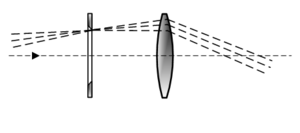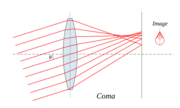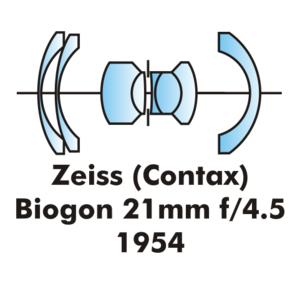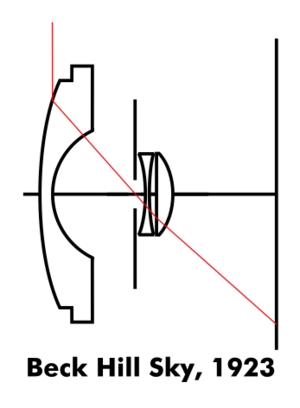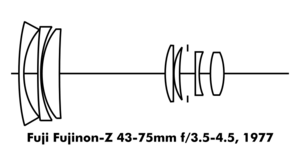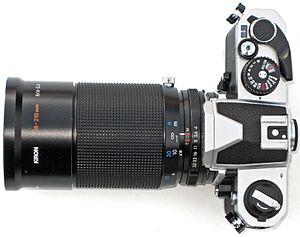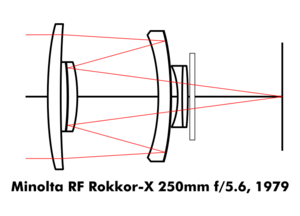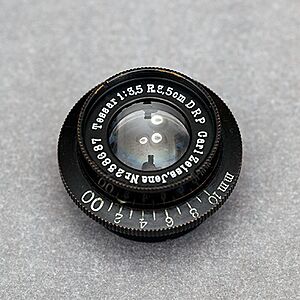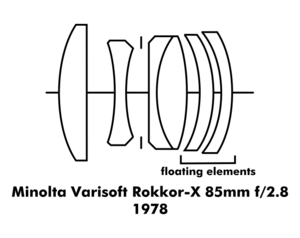History of photographic lens design facts for kids
The invention of the camera in the early 1800s brought about many new lens designs for photography. Even before cameras, people knew about the challenges of making lenses. These lenses needed to cover a large, flat area for the camera obscura.
Contents
Early Camera Lenses (1800–1890)
Early photographers like Thomas Wedgwood and Louis Daguerre used simple, single-element lenses. These lenses had problems. They couldn't focus a clear image across a large, flat film area. This problem is called field curvature. They also suffered from other optical aberrations, which are like blurry spots or color fringes.
One big issue was chromatic aberration. This meant that the colors photographers saw (often yellow) didn't focus at the same spot as the colors the film was sensitive to (often blue). This made it very hard to get a sharp picture.
- Some lens problems early photographers faced
In 1829, Charles Chevalier made an achromatic lens for Daguerre. This lens used two different types of glass, crown glass and flint glass. It helped reduce chromatic aberration. Chevalier changed the lens, which was first made for a telescope, to make the image flatter. He also made it focus blue light more sharply. This lens was used in the first daguerreotype cameras in 1839.
The Meniscus or 'Landscape' Lens
In 1804, William Hyde Wollaston invented a meniscus lens for eyeglasses. He later used it for the camera obscura in 1812. He put an opening in front of it, making the lens sharp over a wide area. Niépce and Daguerre used this lens. However, it was a single lens and couldn't control color problems. This made it hard to focus accurately with the blue-sensitive daguerreotype process.
By 1839, Chevalier made an achromatic version of the meniscus lens. This lens helped flatten the image and control color problems. It became known as the "French landscape lens" or "landscape lens." It was good for wide views but was "slow" (f/16). This meant outdoor pictures took twenty to thirty minutes.
The Petzval Portrait Lens
Because the Landscape lens was slow, a prize was offered in 1840 for a faster one. Joseph Petzval, a math professor, took on the challenge. With help from human calculators, he created the Petzval Portrait lens in 1840.
This lens was made of four elements and was very fast at f/3.6. It was the first lens designed for portraits. It allowed for one- to two-minute outdoor daguerreotype exposures. With the faster collodion process in the 1850s, indoor portraits became possible in the same time.
In 1841, a camera was made specifically for the Petzval lens. This was the first camera and lens designed together for photography. The Petzval Portrait lens was popular for almost a century. It had some image problems, but it was sharp in the center. The edges would softly blur, creating a nice effect around the subject. This lens is still used today for projectors.
Fixing Optical Problems
The Achromat Landscape lens also caused straight lines to look curved. This was a big problem for architecture photos. Also, photos of faraway places were popular. This problem got worse as the field of view got wider.
The first successful wide-angle lens was the Harrison & Schnitzer Globe in 1862. It had a wide view of about 80 degrees. This lens had a special symmetric design. This symmetry helped fix problems like distortion and color fringes.
This symmetric design influenced the Dallmeyer Rapid-Rectilinear and Steinheil Aplanat lenses. These lenses, made in 1866, were very similar. They fixed most optical problems, except for some blur and field curvature, at f/8. These lenses became the standard general-purpose lenses for over 50 years.
These four types of lenses—Landscape, Portrait, Globe, and Rapid-Rectilinear/Aplanat—were all the lenses photographers had in the 1800s.
Aperture Stops
It was known since the 1500s that an opening, or aperture stop, could make a lens image better. This is because a stop in the center blocks light that causes blur. Even today, most lenses work best at their middle apertures.
Early lenses didn't have adjustable stops. Their small openings and the slow daguerreotype process meant exposures took many minutes. Photographers didn't want to block more light. But when the faster wet collodion process came out in 1851, exposure times got shorter. This made adjustable stops useful.
The first adjustable stops were Waterhouse stops from 1858. These were brass plates with different sized holes. They were inserted into a slot in the lens.
Around 1880, photographers realized that aperture size also affected depth of field. This is how much of the scene is in focus. Adjustable stops became a standard lens feature. The iris diaphragm, which is like the iris in your eye, appeared in the 1880s. It became the standard adjustable stop around 1900.
Modern lens aperture numbers (like f/1, 1.4, 2, 2.8) were standardized in 1949.
Telephoto Lenses
A simple camera lens is as long as its focal length. For example, a 500mm lens needs 500mm between the lens and the film. A telephoto lens is made to be physically shorter than its focal length. It uses a front lens group that focuses the image and a rear group that magnifies it. This makes the lens much shorter.
Originally, you could buy extra negative lenses to attach to the back of a regular lens. The Barlow lens, invented in 1833, is still used to increase telescope magnification. The teleconverter is the modern version for cameras.
In 1891, Thomas Dallmeyer and Adolf Miethe both tried to patent new telephoto lens designs. These were complete lenses with a front and rear group. The first telephoto lens that was optically corrected as a system was the f/8 Busch Bis-Telar in 1905.
Anastigmat Lens Designs (1890–1950)
Zeiss Protar
Lens design took a big leap in 1890 with the Zeiss Protar. This was the first successful anastigmat lens. Anastigmat means it was highly corrected for almost all lens problems, including astigmatism. It could be made for different uses, from f/4.5 portraits to f/18 super wide angles.
The Protar is seen as the first "modern" lens. It used new types of glass invented by Ernst Abbe and Otto Schott in 1884. These new glasses allowed for more freedom in lens design. Most good quality photographic lenses since 1930 are anastigmat corrected.
Today, even better lenses exist called apochromatic lenses. They correct problems even more strictly. These lenses use special rare earth or fluorite glasses. The first apochromatic lens for regular cameras was the Leitz APO-Telyt-R 180mm f/3.4 in 1975.
Cooke Triplet
The Taylor, Taylor & Hobson Cooke Triplet from 1893 was a very important lens. Harold Taylor created this simple-looking lens by rethinking lens design. It used the new Schott optical glasses to its advantage.
The Cooke Triplet became the standard "economy" lens of the 1900s. For example, the Argus Cintar 50mm f/3.5 for the Argus C3 camera used a Cooke triplet. This lens was good enough for contact prints and small enlargements from 35mm cameras.
Tessar
Paul Rudolph developed the Tessar lens because he wasn't happy with his earlier Protar. The Tessar started as an f/6.3 lens and was improved to f/2.8 by 1930.
The Tessar was the standard high-quality, normal lens for much of the 20th century. Many famous cameras used a Tessar lens, like the Kodak Anastigmat Special 100mm f/3.5 on the Kodak Super Six-20 (the first autoexposure camera).
Ernostar and Sonnar
Once anastigmat lenses were good, people wanted lenses that could work in lower light. The Ernemann Ernostar from 1923 was the first common lens with a very wide aperture. Ludwig Bertele improved it to f/1.8 in 1924.
This lens, on the Ernemann Ermanox camera, helped start modern photojournalism. Bertele continued to develop the Ernostar under the more famous Sonnar name after his company joined Zeiss. He reached f/1.5 in 1932 with the Zeiss Sonnar 50mm f/1.5 for the Contax I camera.
The Sonnar was also popular as a telephoto lens. The Zeiss Olympia Sonnar 180mm f/2.8 from 1936 is a famous example.
Asymmetric Double Gauss
In 1817, Carl Friedrich Gauss improved telescope lenses. Later, in 1888, Alvan Clark put two of these lenses back to back. This became the basis for the Double Gauss design.
The modern design comes from 1895, when Paul Rudolph of Carl Zeiss Jena used special cemented lenses to fix color problems. This design was further developed in the 1920s by Taylor Hobson. It led to high-performance lenses with wide apertures.
This design is still used today for many camera lenses, especially fast standard lenses for 35mm cameras. It can give good results even at f/1.4 and has a wide field of view. It's used in affordable, high-quality lenses like the Canon EF 50mm f/1.8 and Nikon 50 mm f/1.8D AF Nikkor.
Mid-Century Developments (1950–1980)
Retrofocus Wide-Angle Lenses
Regular wide-angle lenses need to be mounted very close to the film. However, SLR cameras need space for a mirror to move. This led to the invention of retrofocus lenses. These lenses use large negative elements in front to make the lens focus further away from the film. This creates enough space for the mirror.
In 1950, the Angénieux Retrofocus Type R1 35mm f/2.5 was the first retrofocus wide-angle lens for 35mm SLRs. "Retrofocus" was originally a brand name but became a general term. Retrofocus lenses are very complex and hard to correct for distortion. But their large front elements also help reduce light loss at the edges of the image.
Many normal lenses for today's digital SLRs are retrofocus. This is because digital sensors are smaller than 35mm film. They need shorter focal lengths for the same view, but still need space for the mirror.
Fisheye Lenses
A fisheye lens is a special type of ultra-wide-angle retrofocus lens. It doesn't try to correct for straight lines appearing curved. Most fisheyes create a circular image with a 180-degree view. The name comes from how a fish might see the sky.
The first fisheye lens was the Beck Hill Sky lens in 1923. It was designed to point straight up and take 360-degree sky images for studying clouds.
Fisheye lenses were mainly used for science at first. But in 1957, LIFE magazine published the first widely seen fisheye photos. The first widely available fisheye lens for 35mm cameras was the Fisheye-Nikkor 8mm f/8 from Nikon in 1962. It made circular images. Later, in 1963, Asahi Optical released the first "full-frame" fisheye lens, the Fish-eye-Takumar 18mm f/11. This lens covered the whole frame with a 180-degree view.
Macro Lenses
Macro photography is about taking pictures of very small things up close. The image size is often the same as the real object (1:1 ratio) or even larger. "Macro" lenses were originally regular lenses that were good for close-up shots. They were used with extension tubes or bellows to get close focus.
However, the Kilfitt Makro-Kilar 4cm f/3.5 from 1955 changed what a macro lens meant. It was the first lens that could focus continuously from far away (infinity) to very close (1:1 life-size). SLR cameras were best for macro lenses because they don't have viewfinder problems when focusing very close.
Designing close-up lenses is not too hard. The challenge is getting a sharp image continuously from infinity to very close. Most SLR macro lenses today have longer focal lengths than the Makro-Kilar. This gives more working distance between the lens and the subject.
Supplementary Lenses
A supplementary lens is an extra lens that attaches to the front of your main lens. It changes the lens's focal length. If it's a positive lens, it makes the focal length shorter and allows closer focusing. These "close-up lenses" are often simple and cheap.
An afocal attachment is a more advanced supplementary lens. It's like a small telescope that attaches to the front of a lens. It changes the focal length without moving the focus point. There are telephoto types (to zoom in) and wide-angle types (to zoom out).
Afocal attachments can reduce image quality. But they were a cheap way to get different focal lengths before zoom lenses were common. Some, like the Zeiss Tele-Mutar 1.5× and Wide-Angle-Mutar 0.7× (1963), were high quality. They could change a Rolleiflex camera's 75mm lens into a 115mm or 52mm equivalent.
Zoom Lenses
Zoom lenses developed from telephoto lenses. Changing the distance between a telephoto lens's front and rear parts changes its magnification. But this also affects focus and image quality. A true zoom lens needs extra parts to keep the focus steady.
The first zoom lenses for still cameras appeared between 1929 and 1932 for professional movie cameras. The first for still cameras was the Voigtländer-Zoomar 36-82mm f/2.8 in 1959. It was very large and heavy.
Early zoom lenses often produced poor images. They were okay for TV or amateur movies, but not for still photos. However, efforts to improve them continued.
Zoom Lens Development
In 1974, the Vivitar Series 1 70-210mm f/3.5 Macro Focusing Zoom was praised as the first professional-quality "macro" zoom lens. Its complex design was possible thanks to new digital computers.
Early zooms often had two separate rings for focus and zoom. The Vivitar Series 1 used a single ring: twist to focus, push-pull to zoom. This "one-touch" zoom was popular for a while. But when autofocus cameras came out in 1985, focus and zoom controls had to be separate again.
In 1977, the Fuji Fujinon-Z 43-75mm f/3.5-4.5 became the first zoom lens sold as the main lens for a camera with interchangeable lenses. The Sigma 21-35mm f/3.5-4 from 1981 was the first super-wide-angle zoom lens for still cameras. Combining wide-angle, retrofocus, and zoom features was a big achievement.
Widespread Use of Zoom Lenses
In the last 25 years, there's been a demand for one lens that can do everything. The Kino Precision Kiron 28-210mm f/4-5.6 from 1985 was the first "superzoom" lens. It could replace many prime lenses, from wide-angle to telephoto. It had a small variable maximum aperture to keep its size and cost down.
Early 35mm SLR zooms rarely had a focal length range more than 3 to 1. But zoom lenses kept improving. Despite some image quality trade-offs, wide-range zoom lenses became common on amateur SLRs by the late 1990s. They are still standard on digital SLRs today, with ranges up to 19X.
The Tokina SZ-X 70-210mm f/4-5.6 SD from 1985 was the first ultra-compact zoom. It was half the size of other 70-210mm zooms. It used new glass and a special zooming action to reduce size and weight.
Small aperture lenses became practical in the 1980s with high-sensitivity ISO 400 color films. Point-and-shoot cameras with compact zooms became very popular in the 1990s.
Today, many wide-range zoom lenses are "varifocal" instead of "parfocal." This means the focus point shifts when you zoom. But autofocus cameras usually correct this automatically.
Rise of Japanese Optical Industry
Japanese photographic lens production started in 1931. By 1950, they were making very high-quality lenses. In 1954, the Japan Camera Industry Association (JCIA) started promoting a high-quality photography industry. They banned copying designs and exporting low-quality equipment.
By the late 1950s, Japanese lenses were seriously competing with German ones. For example, the Nippon Kogaku Nikkor-P Auto 10.5cm f/2.5 from 1959 is considered one of the best portrait lenses ever. In 1963, the Tokyo Kogaku RE Auto-Topcor 5.8cm f/1.4 came out. These lenses showed that the Japanese optical industry was becoming better than the German one. German companies had been leaders for a century but became less innovative after World War II.
Early Japanese lenses often used existing designs. But around 1960, they started creating new ones. The Nippon Kogaku Auto-Nikkor 8.5–25cm f/4-4.5 (1959) was the first telephoto zoom for 35mm still cameras. The Canon 50mm f/0.95 (1961) had a super-wide aperture. The Nippon Kogaku Zoom-Nikkor Auto 43-86mm f/3.5 (1963) was the first popular zoom lens.
Catadioptric "Mirror" Lenses
Catadioptric lenses (or "CAT" lenses) combine mirrors and lenses. They fold the light path, making the lens physically shorter than its focal length. This design helps correct common optical errors found in mirror systems.
The first general-purpose CAT lens for photography was Dmitri Maksutov's 1944 MTO 500mm f/8. CAT lenses were popular in the 1960s and 1970s before better telephoto lenses were available. CAT lenses of 500mm focal length were common. Some were as short as 250mm, like the Minolta RF Rokkor-X 250mm f/5.6 (1979).
Mirror lenses fell out of favor in the 1980s. However, large astronomical telescopes that use mirrors are still available and can be used with cameras.
Movable Element Prime Lenses
The complex movements of zoom lenses were also used in prime lenses. Traditionally, prime lenses focused by moving the whole lens. But the best way to correct problems might be different for close and far objects.
So, some prime lenses started using "floating elements." These elements move separately from the main lens to keep good image quality at close distances. For example, the Nippon Kogaku Nikkor-N Auto 24mm f/2.8 (1967) had a system where a rear group of elements moved separately. This kept image quality good even at close focus.
Other prime lenses started using "internal focusing." This means only a few internal elements move for focusing. This keeps the lens's weight balanced. Internal focusing became popular for heavy telephoto lenses. It also became important for autofocus cameras because it saves battery power and makes the focusing motor work less.
Modern Developments (1980+)
Inexpensive Aspheric Lenses
Most lens elements have spherical (curved like a ball) surfaces. But this can cause problems like spherical aberration, especially in wide-angle or wide-aperture lenses. This problem can be fixed by using elements with complex aspheric (not perfectly spherical) curves. Making these was very hard and expensive for a long time.
The first camera lens with an inexpensive, mass-produced molded glass aspheric element was the 12.5mm f/2.8 lens in the Kodak Disc cameras (1982). These cameras had very advanced engineering for their time.
Kodak started using molded plastic aspheric elements in viewfinders in 1957. The Kodak Ektramax camera (1978) had a Kodak Ektar 25mm f/1.9 lens with a molded plastic aspheric element. Plastic is easy to mold into complex shapes. However, glass is better than plastic for lenses in many ways, like its refractive index and strength.
Autofocus Lenses
Autofocus (AF) is mostly an electronic feature of the camera, not just the lens. It didn't change lens design much. The main changes were mechanical: internal focusing became popular, zoom lenses went back to "two-touch" controls, and lenses included AF motors or gears and electronic chips.
The first autofocus lens for a still camera was the Konishiroku Konica Hexanon 38mm f/2.8 in the Konica C35 AF (1977). The first interchangeable AF SLR lens was the Ricoh AF Rikenon 50mm f/2 (1980). The first complete line of autofocus lenses was introduced with the Minolta Maxxum 7000 (1985).
Image-Stabilized Lenses
In 1994, the 38-105mm f/4-7.8 lens in the Nikon Zoom-Touch 105 VR was the first consumer lens with built-in image stabilization. This system could detect and correct camera shake. It allowed photographers to take sharp pictures in low light without a tripod. Image stabilization was a big new feature in the 1990s.
The Canon EF 75-300mm f/4-5.6 IS USM (1995) was the first interchangeable lens with built-in image stabilization. These lenses were expensive at first. But stabilization became popular in amateur digital SLRs around 2006. Some cameras now have stabilization built into the camera body, moving the image sensor instead of lens elements.
Diffractive Optic Lenses
With computer design and new materials, it's now possible to control most lens problems. But color problems (chromatic aberrations) are still hard to fix.
In 2001, the Canon EF 400mm f/4 DO IS USM was the first diffractive optics lens for consumer cameras. This lens uses special elements with tiny circular patterns. These patterns use diffraction to correct color and spherical problems. This means the lens can be smaller and lighter.
As of 2010, there were only two expensive professional diffractive optics lenses. But if the technology proves useful, prices might drop, and they could become more popular.
Lenses in the Digital Era
In 2004, some digital SLRs started correcting lens problems automatically. For example, the Kodak DSC Pro SLR/c could correct color problems for 110 lenses. Also, software like DxO Labs could correct distortion, vignetting, and blur in images after they were taken.
Today, some lenses are designed to have problems that are then fixed by the camera's software. For example, images from the 2009 Panasonic 14-140mm f/4-5.8 G VARIO ASPH. MEGA O.I.S. lens have their severe barrel distortion automatically reduced by Panasonic cameras.
Lens Design Trends and Considerations
Anti-Reflection Coating
In the 1800s, light reflecting off lens surfaces was a big problem. Each glass-air surface could lose 4 to 8 percent of light. This made images dim and caused flare (unwanted light scattering). This limited how many elements a lens designer could use.
Some lenses were marked with T-stops (transmission stops) instead of f-stops. T-stops showed the actual amount of light passing through the lens. This was useful for movie cameras to ensure consistent exposure.
In 1886, people noticed that some old, tarnished lenses actually produced brighter images. This was because the oxidation layer on the glass reduced reflections. In 1935, Alexander Smakula invented "single-coating" lenses. This involved putting a very thin layer of magnesium or calcium fluoride on the glass in a vacuum. This could cut reflections by two-thirds.
Anti-reflection coatings were very important for movies like Gone with the Wind. They made images brighter and sharper. A typical uncoated movie lens could lose over 41 percent of light. With coating, an f/2.3 lens could give the same brightness as an f/1.6 lens, but with better quality.
In 1941, the Kodak Ektra camera was introduced with the first complete line of anti-reflection coated lenses for consumers. After World War II, coated lenses became standard for high-quality cameras.
The availability of anti-reflection coating helped the Double Gauss lens become more popular than the Sonnar. Before coating, the Sonnar was preferred because it had fewer air-glass surfaces, making it less prone to flare. But with coating, the Double Gauss's design advantages became clear.
Modern lenses use "multicoating," with many different layers of chemicals. This reduces reflections even more, to about 99.7% efficiency. Multicoating is essential for today's complex zoom lenses with many elements.
Bokeh
Bokeh is how the out-of-focus parts of an image look. In the past, lens designers focused only on making the in-focus image sharp. So, the blurry parts of the image could look different with different lenses. These differences can affect how good an image looks overall.
There's no exact definition of bokeh, as it's a matter of taste. But symmetrical lens designs often produce pleasing bokeh. Mirror lenses create a unique "donut" shaped bokeh because of their central mirror.
In the 1970s, with more powerful computers, Japanese lens makers started studying bokeh. The Minolta Varisoft Rokkor-X 85mm f/2.8 (1978) was an early result. It used floating elements to let the photographer control how blurry highlights looked.
Today, bokeh is a normal design goal for high-quality lenses. However, for small-sensor cameras like smartphones, bokeh is less important. Their lenses have a very large depth-of-field, so almost nothing is out of focus.
Improving Quality Standards
Lenses have gotten better over time. On average, modern lenses are sharper than older ones.
Image sensor sizes have been shrinking, but print sizes have stayed similar. Newer lenses have higher resolving power to keep print quality high, even with more enlargement. For example, if you want a sharp A4 print viewed from 30cm, a 35mm film lens needs to resolve at least 40 lines per millimeter.
Optical engineers constantly use more exact lens formulas. In the 1800s, they calculated for "third-order aberrations." By the mid-1900s, they needed "fifth-order aberrations." Today's lenses require "seventh-order aberration" solutions.
The best lenses from the past were very high quality. It might be hard to prove that today's best lenses are superior without comparing very large prints side-by-side.



